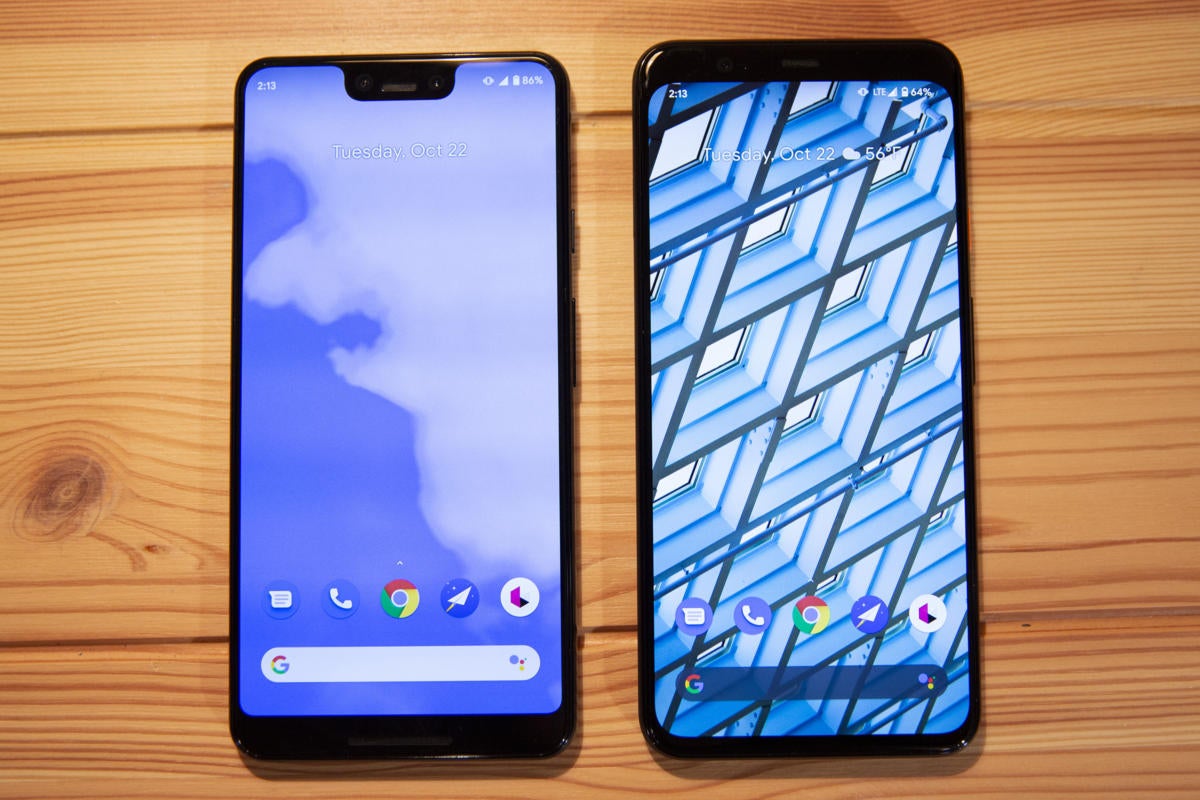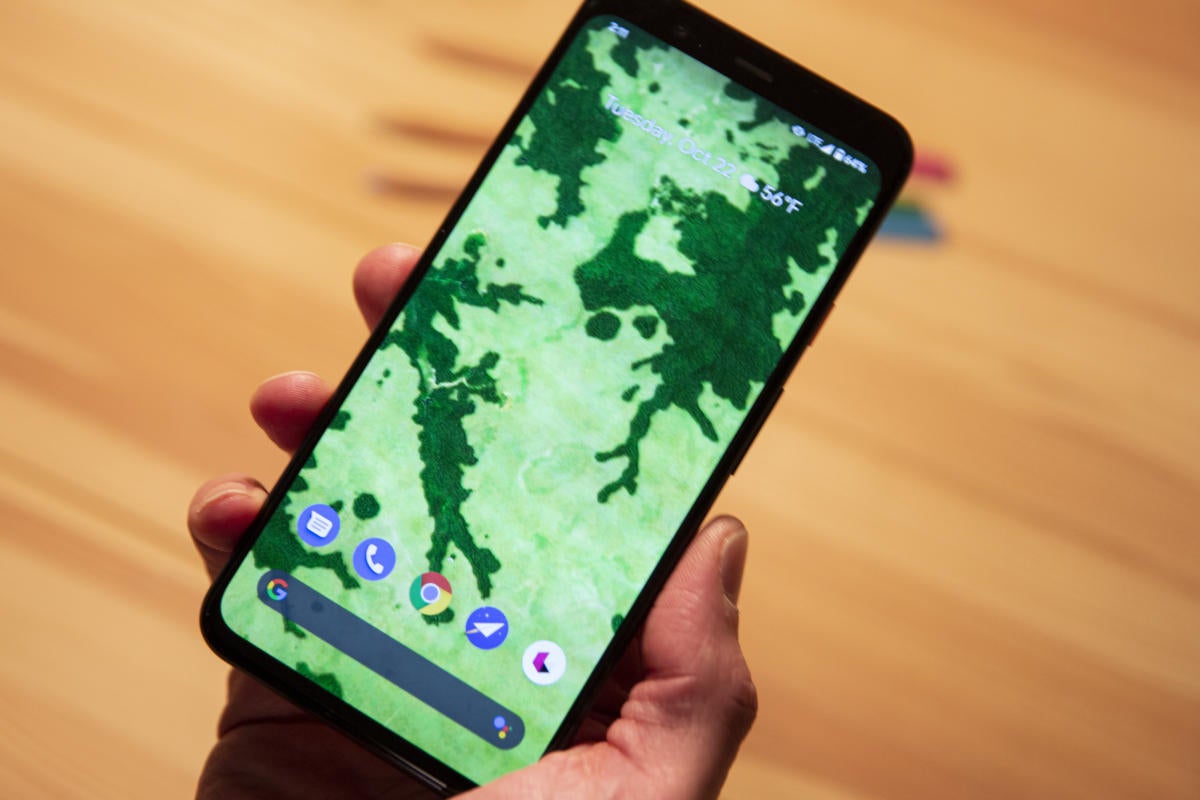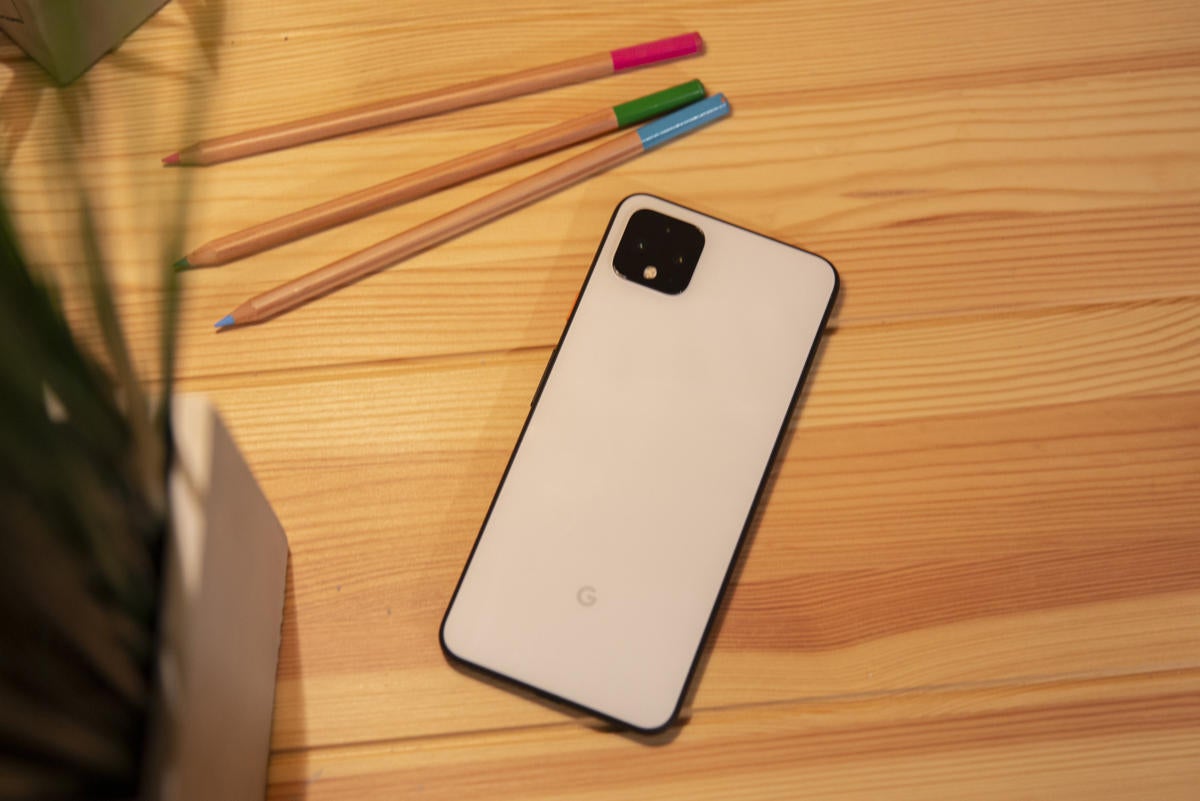The Google Pixel 4 XL can lay claim to the only real smartphone breakthrough of the year: a shrunken radar chip that’s so advanced it can detect when you reach for your phone so you’ll never have to stare at a blank screen.
It’s a delightful feature that makes phones with ambient or always-on displays feel like they’re stuck in the past. Combined with Face unlock, the Pixel 4’s Motion Sense technology makes me feel like the phone anticipates all my moves, and this truly saves time by limiting how often I need to tap the screen. Before you even unlock it, the Pixel 4 XL exudes futurity and sets you up for an experience unlike anything you’ll find on a Galaxy or iPhone.
Unfortunately, the rest of the Pixel 4’s innovations are still several software updates away. Once you get past the lock screen, the Pixel 4 XL is basically an iterative upgrade over the Pixel 3—which is still for sale, and for hundreds of dollars less. The new model introduces features that need more time to bake, a few shortcomings that should have been fixed before launch, and a camera that isn’t impressive when compared to the competition. Google may have delivered its most ambitious phone with the Pixel 4 XL, but it falls well short of nailing a top-tier phone experience.
Design: Taking the fun out of functional
Like the Google and Nexus phones that came before it, the Pixel 4 XL is a bland, perfunctory handset that looks downright ugly next to the Galaxy Note 10+ or iPhone 11 Pro. While other phone makers are racing to be the first with a 100 percent screen-to-body ratio, the Pixel 4 is nearly 20 percent bezel and extremely top-heavy to boot.
 Christopher Hebert/IDG
Christopher Hebert/IDGThere’s no notch on the Pixel 4 XL (front), but the bezel is very much still there.
Gone is the Pixel 3’s laughably large notch, but in its place is a bezel that’s straight out of 2016. No fewer than seven sensors and a speaker occupy the space above the screen, but all you’ll see is an unsightly strip of black glass. The sizable top bezel extends to the sides and the bottom, where there’s no balance or symmetry. It’s small enough to push the speaker to the bottom edge, and from afar, the Pixel 4 will look more like a budget phone than a premium one. And even up close, there’s nothing about it that looks like it should cost $900.
Around the back you’ll find the Pixel 4’s most obvious upgrade: a dual camera. Like the iPhone 11, the Pixel 4 has a giant square camera array in the top left corner that’s designed to stand out, particularly in white or orange. However, while the camera array is very much a fluid part of the iPhone 11 despite its size, the Pixel 4’s camera bump feels like an afterthought that was tacked on after the phone’s design was already finished.
 Christopher Hebert/IDG
Christopher Hebert/IDGThe orange power button on the Pixel 4 XL is my favorite design element.
That said, the Pixel 4 has the nicest hand feel of any phone I’ve ever used. From the frosted glass back to the polished aluminum sides, there isn’t a speck of gloss apart from the front and the “G” logo, and the visual and tactile contrast is palpable. The back is practically silky to the touch, giving the Pixel 4 an even more luxurious feel than the iPhone 11 Pro, and it’s remarkably resistant to scuffs, smudges, and scratches. But my favorite design element continues to be the colored power button, which is orange on the white model I tested. It’s subtle, but it adds a bit of whimsy to an otherwise staid and, ahem, buttoned-up design.
The Pixel 4 doesn’t include a headphone jack, which isn’t a surprise, but it also doesn’t come with a pair of USB-C earbuds or a 3.5mm adapter, which is a bit shocking. The Pixel 3, Galaxy S10, and iPhone 11 all come with an audio contingency plan, so I really don’t understand the decision here. It makes it feel like Google is nickel-and-diming its customers, and coupled with a not-great design, it gives the Pixel a cheap vibe.
Face unlock: Quick and accurate with little support
The Pixel 4 brings a handful of new features that set it apart from both the Pixel 3 and Google’s 2019 competitors, and they’re all designed to enhance your daily smartphone routine without much adjustment or re-learning.
Let’s start with Face unlock. Where virtually every other Android phone relies on a fingerprint sensor to keep your phone locked from prying eyes, the Pixel 4 has a 3D camera for secure facial recognition. It’s something no other U.S. Android phone has, and only the LG G8 with its time-of-flight sensor has something similar. That means after more than two years there’s finally an Android Phone that can rival Apple’s TrueDepth camera and Face ID, an overdue milestone that will hopefully spur other phone makers to follow suit.
 Christopher Hebert/IDG
Christopher Hebert/IDGThe Pixel 4 XL’s top bezel hides an array of tech, including 3D facial recognition.
And it works really well. While Face unlock on the Pixel 4 requires more precise positioning than Face ID on the iPhone 11, for a first-gen feature, I was impressed. It works on the first try better than 95 percent of the time, and it offers some subtle improvements over Apple’s method. For one, there’s a small bit of haptic feedback to let you know it works, so you can stop holding your phone up. And there’s an option to let you skip right to the home screen once it recognizes your face, saving a swipe and making the whole system feel far quicker and more integrated.
However, there’s a big caveat to Face unlock: It’s less secure than Apple’s Face ID, at least for now. That’s because Face unlock doesn’t track your eyes, so someone could conceivably hold your Pixel 4 up to your face while you’re sleeping and unlock it. That’s not as big of a vulnerability as a third-party screen protector giving you access to the Galaxy S10, but it should raise some eyebrows.
Granted, this probably won’t be a concern for most people, but as the phone’s only biometric-based unlocking method, one would think Google would have made it as foolproof as possible. As it stands, Google has issued a vague promise to update it “in the coming months.” Attention awareness is something Face ID had from day one, and in an age of privacy and security, it’s a glaring omission in an otherwise welcome feature.
Equally frustrating is Face unlock’s lack of app support. Since Google has taken away the fingerprint sensor, you’re going to be typing your password a lot because only a small handful of apps (including Chrome and Google Pay, naturally) have signed on to support the Pixel 4’s new biometric. Thankfully, most password managers aside from LastPass will hook into Face unlock, but after you’ve logged in, any repeated authentication will require a passcode. That’s a major step backward, and given Android’s history, we’re not convinced those app updates will arrive in a timely fashion.
Motion Sense: Good now, better later (maybe)
The Pixel 4’s most unique feature is a miniaturized radar chip that powers the gesture-based Motion Sense. It works far better than similar features in other phones, but just like Face unlock, it’s an update or two away from being truly useful.
 Christopher Hebert/IDG
Christopher Hebert/IDGEven without a notch, the Pixel 4 XL (right) is essentially the size as the Pixel 3 XL. But the new phone has some futuristic tech in the top bezel.
In a vacuum, Motion Sense is the first real breakthrough for a smartphone in years. It works without an app or any real instructions, and the learning curve is easy enough to be mastered in seconds. Basically, you’re interacting with your phone’s screen the way Tony Stark uses a virtual screen to create the Iron Man suit: swipes and waves rather than taps and pinches.
In a practical sense, however, Motion Sense on the Pixel 4 is nowhere near superhero status. Here’s what it can do:
- Detect when you reach for your phone and light up the lock screen.
- Skip to the next or previous track.
- Snooze an alarm.
- Dismiss a timer.
- Silence the ringtone on an incoming call.
That’s it. You can’t raise the volume, pause a song, hang up on an incoming call, dismiss a notification, launch an app, flip the camera, take a picture, or anything else you could conceivably want to do without touching your phone. Some of those things are surely coming down the pike, but as it stands, Motion Sense is extremely limited and not very useful—a neat trick in search of a party.
Still, Google deserves points for developing a system that actually works. Where Air Motion on the LG G8 is a finicky experience that requires more precision and patience than most people would be willing to extend, Motion Sense works the first time (nearly) every time. So there’s definitely a solid foundation to work with.
New Assistant: Great if you can get it
The Pixel 4 is also the showcase for the “new” Google Assistant, which is basically a streamlined interface and a faster response time. I didn’t get anywhere near the rapid-fire speed that was demoed at Google I/O in May, but it’s definitely improved.
The new Assistant interface is the bigger story, and it’s vastly better than any other AI chatbot, including Assistant on other devices. Instead of a window that takes over part (or all) of your screen, Assistant occupies a tiny space at the bottom of the display that will only expand to show you what you need to see. With Continued Conversation enabled, you’ll be able to ask follow-up questions in quick succession, and I didn’t experience any issues with it understanding me (though issues are rare with the old Assistant too).
 Christopher Hebert/IDG
Christopher Hebert/IDGThe new Assistant on the Pixel 4 is faster and less intrusive.
Google hasn’t indicated when or if the new Assistant will be arriving on other devices, though I have to assume it will. Before that happens, however, a few things will need to be cleared up. For one, the new Assistant only works if you have gesture navigation enabled. If you don’t, it will revert to the old interface. I assume that’s due to the nav bar getting in the way of Assistant’s new home, but that’s a weird requirement since Android 10 is keeping the old method around.
Even more confounding is the new Assistant’s inability to play nicely with G Suite for Business accounts that are separate from whatever Google account you set for the phone’s main profile. Even if there’s a dormant secondary G Suite account on your phone, it will block the new Assistant from showing up for some reason, and it won’t appear unless the second account is completely removed. And in true Google fashion, there isn’t any warning or explanation, so G Suite users might not even realize they’re missing anything. That’s simply unacceptable for a major feature on a thousand-dollar phone.
Elsewhere, the Pixel 4 serves as a showcase for Android 10’s newest features, most notably dark mode and gesture navigation. Pixel users will be somewhat familiar with Android’s gestures, but it’s a bit different here, with the pill and back buttons replaced with an iOS-style action bar. It’s a little and clunky and not nearly as intuitive as it is on the iPhone, particularly when it comes to the back gesture. You’re supposed to be able to swipe from the left or right edge to go back a screen, but sometimes menus get in the way. All in all, it still needs work. Dark mode, on the other hand, is far more refined, with nearly every Google app and system screen supporting it.
But my favorite feature is Live Caption. When it’s turned on, any video from any source will automatically transcribe captions based on what’s playing, and it’s surprisingly spot on most of the time. The same goes for the excellent new Recorder app, which will record and transcribe the words it hears. Neither is perfect, but they’re both incredibly useful and sure to improve quickly thanks to a healthy dose of machine learning and AI smarts. I assume both of these features will eventually be available on other Pixel and Android phones, but for now they’re exclusive to the Pixel 4.
Performance: A good display, OK everything else
Strip away the new features, and the Pixel 4 XL trails its peer a bit on the spec sheet, with the RAM, storage, and battery all on the skimpy side:
- Display: 6.3-inch QHD+ OLED, 537ppi
- Processor: Snapdragon 855
- RAM: 6GB
- Storage: 64GB/128GB
- Battery: 3,700mAh
The Pixel 4 is plenty fast (though I found the Settings app hung a second or two before loading), but a phone launching so late in 2019 really should be using the 855+ chip. And while Google has finally admitted that 4GB of RAM just doesn’t cut it for a high-end Android phone anymore, 6GB isn’t so great either. Compared to the Pixel 3, my Pixel 4 kept a few more apps in its Recents carousel, but neither holds a candle to the dozens that were visible on the S10+. And while we’re at it, why is Google still charging $100 for an extra 64GB of storage? Even Apple charges half that.
 Christopher Hebert/IDG
Christopher Hebert/IDGGoogle finally delivered an excellent smartphone screen in the Pixel 4 XL, even if the 90Hz Smooth Display isn’t all that.
Somewhat surprisingly, Google shines in its new display game. Pixel phones have had long-standing issues with their screens, from OLED burn-in to flat colors, but the Pixel 4 is the first to get it right. It’s still not quite as bright as the Note 10+ or as vibrant as the iPhone 11 Pro, but the display on the Pixel 4 is easily the best Google has delivered. The blacks are deeper and the colors are more vibrant than the Pixel 3, and the oleophobic smudges that plagued earlier models are nowhere to be seen (so far, anyway). And I really liked the new Ambient EQ feature that adjusts the white balance based on the light in the room. Similar to Apple’s True Tone display, it makes the screen much easier on the eyes without the often jarring auto brightness adjustments.
The Pixel 4 also introduces Smooth Display, which ups the refresh rate to 90Hz for smoother and speedier scrolling and swiping. It’s one of only a few devices to boast such a feature, but the difference here isn’t as immediately obvious over the Pixel 3 or even switching between 60Hz or 90Hz in the settings. That’s somewhat due to the Pixel’s natural hardware-software integration, but it’s also because it actually only turn on if your brightness is set to greater than 75 percent, another limitation that Google fails to advertise. Still, there were times when I honestly couldn’t tell whether Smooth Display was on or off, even when the phone was at max brightness. Google says it will be updating Smooth Display “in the coming weeks,” but for now it’s just another feature that looks good on paper but not so much in practice.
With all of the bells and whistles on, the Pixel 4 XL has extremely average battery life for a phone in this price range. Benchmarks pegged the Pixel 4 XL at around nine hours, and I was able to get through most days with Smooth Display and Motion Sense switched on. However, the battery was more of a constant concern than with the iPhone 11, Galaxy Note 10+, or OnePlus 7T, and I was acutely aware of how much I had left. I did a little better with Smooth Display and Motion Sense switched off, but it wasn’t a dramatic improvement—and besides, that kind of defeats the purpose of buying a Pixel 4 in the first place. With the kind of battery advancements Apple and Samsung are making with their phones, Google’s Pixel optimizations are woefully behind the times.
 Christopher Hebert/IDG
Christopher Hebert/IDGWireless charging on the Pixel 4 XL has been greatly enhanced.
Thankfully, Google seems to be acutely aware of the Pixel 4’s battery issues, so it’s amped up its wireless charging capabilities. While Google basically forced you to buy a Pixel Stand to get fast wireless charging on the Pixel 3, the Pixel 4 delivers 11W charging with any compatible charger. That’s not as fast as the Galaxy S10’s 15W wireless capabilities, but it’s a huge step up from the Pixel 3’s lame 5W offering.
Camera: A second lens makes little difference
If you’re in the market for a new Pixel, the camera is likely the number one reason why. Google built the Pixel name on the strength of its camera, and the fourth version only drives that point home. After telling us for years that a single camera was all you needed, Google has added a second camera to the rear of the phone, marrying a 16MP telephoto lens with the 12.2MP standard wide lens.
 Christopher Hebert/IDG
Christopher Hebert/IDGThe Pixel 4 XL brings a second rear camera this year.
And perhaps Google was right all along. Since previous Pixels have been able to achieve such incredible results with just one lens, the addition of a second lens brings expected rather than exceptional results. Maybe it’s because of the pressure Google has put on the rest of the industry, but the Pixel 4’s camera improvements are largely incremental and not nearly as impressive as previous models. New features such as astral photography mode and dual exposure are fun to experiment with, but ultimately won’t be used all that often, and live HDR is more overdue than revolutionary.
 Michael Simon/IDG
Michael Simon/IDGIn this image of a rainbow-tinted knife, the Pixel 4 (left) mutes the colors of both the floor and the blade, while the iPhone 11 (center) and Pixel 3 XL (right) handle them properly.
That’s not to say it doesn’t take great pics. But so did the Pixel 3. And so do the Galaxy S10 and the iPhone 11. In some tests, the Pixel 4 XL bested its competition and in others, it performed on par. In some, it missed the mark. Take the photo of the knife above. The Pixel 3 XL got the floor color right, while the iPhone excelled at capturing the rainbow pattern in the blade. The Pixel 4 XL’s shot is on the dull side, muting the colors throughout and stripping away the character. The same is true of the skull below, though the Pixel 4 was the only one of the three to maintain the proper color of the wall.
 Michael Simon/IDG
Michael Simon/IDGThe Pixel 4 XL (left) was the only camera that wasn’t tricked into shifting the color on the wall, but it also didn’t capture the vividness of the skull like the iPhone 11 (center) and Pixel 3 XL (right).
In other photos, the Pixel 4 was too aggressive with white balance. In the shot of the Halloween wreath below, only the iPhone was able to capture the true color of the wall without dulling the orange and gold balls. Both the Pixel 3 and the Pixel 4 shifted the balance to purer white, with the Pixel 4 dulling the color and the sheen as a result.
 Michael Simon/IDG
Michael Simon/IDGThe Pixel 4 XL (left) shifted the white balance, which dulled the colors a bit, while the Pixel 3 XL (right) was a little closer but still too blue. The iPhone 11 (center) was the most accurate.
Most surprising, however, is the telephoto’s lens lack of an impact on either zooming or portraits. I thought that the addition of a second telephoto lens would make a huge difference over the Pixel 3, especially after Google’s proclamation that it was more important than an ultra-wide lens. But in straight comparisons, I didn’t see much of a difference. In the portrait photo below, it’s impossible to see the difference between the Pixel 3 and the Pixel 4, even if you zoom in. If anything, the Pixel 3 does a slightly better job with handling skin tones and color.
 Michael Simon/IDG
Michael Simon/IDGThese portraits taken with the Pixel 4 XL (left) and the Pixel 3 XL (right) are extremely similar.
And in this photo below, the Pixel 3’s digital zoom is basically just as good as the Pixel 4’s 2X optical zoom. In fact, if you inspect the Pixel 4 image, you can see some weird colors and graininess on the back wall and the mantle that don’t appear in the Pixel 3’s shot.
 Michael Simon/IDG
Michael Simon/IDGDespite its 2X optical zoom lens, the Pixel 4 XL (left) struggled with this zoomed image, adding artifacts to the mantle and some noise to the back wall, while the Pixel 3 XL’s digital zoom handled it correctly.
The Pixel 3 wowed us with Night Sight last year, but Google’s competitors have caught up fast and exposed its weaknesses. As I documented in a story for Macworld, the iPhone 11’s Night mode bests the Pixel 4 in just about every situation. The biggest problem is the Pixel’s tendency to brighten everything, which often undermines the nuance and integrity of the scene. Apple’s method consistently preserved shadows and lowlights that were lost or washed out by the Pixel. The both did an admirable job, but the iPhone was consistently just a little better, as you can plainly see in the photo below.
 Michael Simon/IDG
Michael Simon/IDGBoth the Pixel 4 (left) and iPhone 11 (right) brightened this super-dark nighttime scene, but Apple retains the shadows and spookiness while Google blows out the ambiance a bit.
And that’s kind of the story with the Pixel 4. While the Pixel 3’s camera put the rest of the smartphone industry on notice, the Pixel 4 shows that Google might not have been prepared for Samsung and Apple to catch up so quickly. (And that’s not to say anything about its inability to record 4K video at 60fps.)
I might be picking nits here and sharing photos that specifically highlight the Pixel 4’s shortcomings, but the fact remains that Google’s competitors have all but closed the gap with their own computational photography systems, and Google’s improvements over the Pixel 3 XL are slight. And I have to assume that anyone who buys a Pixel 4 cares about such subtleties. So while you’ll surely be able to take excellent, gallery-worthy photos with very little effort with the Pixel 4, if you’re looking for another generational leap, you’re going to be disappointed.
Should you buy a Google Pixel 4 XL?
The latest Pixel phone is usually an easy recommendation, but this year’s phone is a bit of a conundrum. So here’s my recommendation: Now is not the time to buy a Pixel 4.
The Face unlock and Google Assistant bugs are too glaring to overlook, and Motion Sense is in desperate need of new features. The camera is still one of the best, but the gap between it and its peers is practically nonexistent, and its tricks aren’t nearly as impressive with a second lens. And the specs are downright blah for a $900 phone. Even the Pixel launcher and the promise of three years of Android updates are less of a reason to buy, as Samsung ups its game with One UI.
The Pixel 4 has more untapped potential than any other phone I’ve used, but it fails at its most important job: being a phone that lives up to its own hype—and price.
This story, “Google Pixel 4 XL review: Half great, half-baked” was originally published by